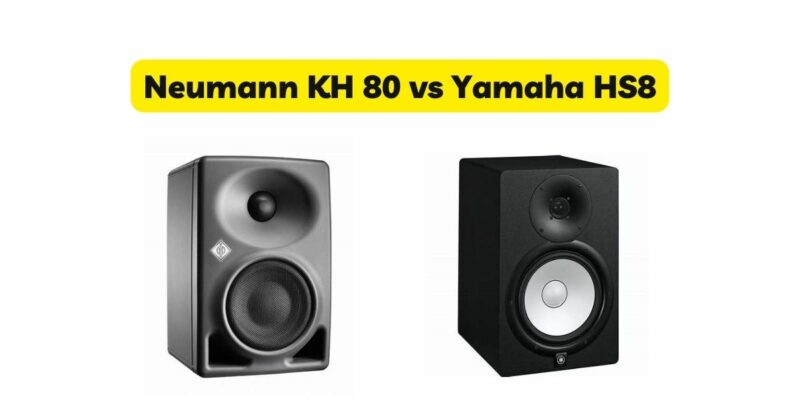When it comes to studio monitoring, having accurate and transparent sound reproduction is crucial. Neumann and Yamaha are two well-respected brands in the audio industry, known for their high-quality studio monitors. In this detailed comparison, we will delve into the differences and similarities between the Neumann KH 80 and the Yamaha HS8. By examining their design, sound performance, connectivity options, and additional features, we aim to help you make an informed decision based on your specific studio requirements.
Design and Build Quality
The design and build quality of studio monitors play a vital role in their performance and longevity.The Neumann KH 80 boasts a compact and robust design. The monitor features a solid aluminum cabinet, which minimizes resonances and provides excellent durability. Its compact size makes it suitable for smaller studio spaces or near-field monitoring setups. The front panel houses a 1-inch tweeter and a 4-inch woofer, both designed and manufactured by Neumann to ensure precise sound reproduction. The KH 80’s design incorporates a Mathematically Modeled Dispersion (MMD) waveguide, which helps in achieving a wide and consistent sweet spot.The Yamaha HS8 showcases a classic and functional design. The monitor features a sturdy MDF cabinet with a carefully designed port system, which enhances bass response and minimizes unwanted resonance. Its larger size makes it suitable for medium-sized studios or those requiring more extended low-frequency capabilities. The HS8 houses an 8-inch woofer and a 1-inch dome tweeter, delivering a balanced and accurate sound across the frequency spectrum. The monitor’s design focuses on providing clear and detailed audio reproduction, making it ideal for mixing and critical listening applications.
Sound Performance
The sound performance of studio monitors is a crucial aspect to consider, as it directly affects the accuracy and quality of audio reproduction.The Neumann KH 80 offers exceptional sound performance, characterized by its precise and transparent sound reproduction. The monitor delivers a well-balanced frequency response, with a clear and detailed midrange, extended high frequencies, and tight and controlled bass response. The KH 80’s MMD waveguide ensures a wide and consistent sweet spot, allowing for accurate monitoring even when moving off-axis. The monitor’s sound signature remains neutral and uncolored, making it an excellent choice for critical listening and professional audio production.The Yamaha HS8 is renowned for its accurate and reliable sound reproduction. The monitor delivers a balanced frequency response, with a clear and detailed midrange, extended high frequencies, and powerful low-end reproduction. The HS8’s larger woofer size provides a more extended bass response, making it suitable for genres that emphasize low-frequency content. The monitor’s sound signature is neutral and transparent, offering an accurate representation of audio material and ensuring reliable mixing decisions.
Connectivity and Additional Features
Both the Neumann KH 80 and the Yamaha HS8 offer versatile connectivity options and additional features to enhance the user experience.The Neumann KH 80 provides flexible connectivity options, including balanced XLR and unbalanced RCA inputs. The monitor also features a ground lift switch, allowing for interference-free operation in various studio setups. Additionally, the KH 80 includes an extensive set of room compensation controls, such as low-mid and high-frequency adjustments, enabling users to tailor the monitor’s response to their specific listening environment. The monitor’s rear panel also features an automatic standby mode, conserving energy when not in use.The Yamaha HS8 offers balanced XLR and unbalanced TRS inputs, ensuring compatibility with a wide range of audio sources and interfaces. The monitor includes room control and high trim switches, allowing for adjustments to compensate for acoustic deficiencies in the listening environment. Additionally, the HS8 incorporates a built-in high-performance bi-amplification system, providing optimal power distribution to the woofer and tweeter for accurate sound reproduction at any volume level.
Price
Price is an essential factor to consider when comparing studio monitors, as it directly affects the overall value and affordability of the product.The Neumann KH 80 falls into the higher price range, reflecting its exceptional build quality, precise sound reproduction, and advanced room compensation controls. The monitor’s price is justified by its engineering excellence and its ability to deliver accurate and transparent sound, making it a top choice for professionals seeking uncompromising audio quality.The Yamaha HS8 is positioned in the mid-price range, offering excellent value for its reliable sound performance, sturdy construction, and versatile connectivity options. The monitor’s price reflects the combination of Yamaha’s brand reputation and the HS8’s ability to provide accurate and detailed audio reproduction in various studio applications.
Conclusion
In conclusion, both the Neumann KH 80 and the Yamaha HS8 are exceptional studio monitors, each with its own strengths and characteristics. The Neumann KH 80 impresses with its compact design, precise sound reproduction, and advanced room compensation controls, making it an excellent choice for critical listening and professional audio production. The Yamaha HS8 stands out with its larger woofer size, accurate sound reproduction, and versatile connectivity options, making it suitable for a wide range of studio applications.When deciding between the Neumann KH 80 and the Yamaha HS8, consider factors such as your studio size, desired sound characteristics, and budget constraints. Both monitors offer excellent performance and value, ensuring accurate and reliable monitoring in your studio environment. Ultimately, the choice between the Neumann KH 80 and the Yamaha HS8 comes down to personal preference, specific studio requirements, and the level of precision and detail you seek in your audio work.

